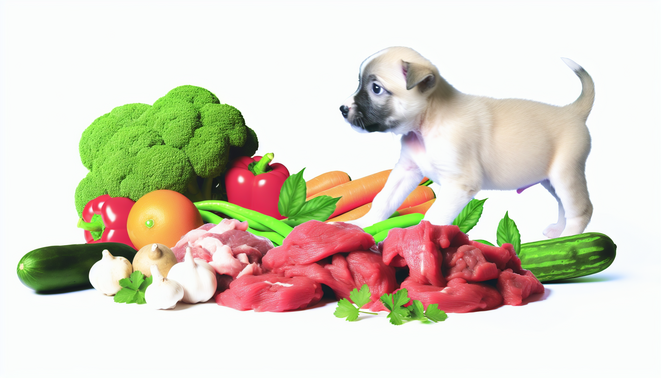“`html
Introduction to the Raw Food Diet for Puppies
The raw food diet for puppies is an increasingly popular choice among dog owners who wish to provide their pets with a natural and holistic nutrition plan. This diet primarily consists of raw meats, bones, organ meats, and sometimes fruits and vegetables. Advocates of the raw food diet argue that it mimics the natural diet of dogs’ wild ancestors, thus promoting better overall health, shiny coats, improved energy levels, and optimal weight management.
Transitioning to this diet requires careful planning and knowledge of nutritional needs tailored to a puppy’s growth stage. Understanding the fundamentals of raw feeding can enhance your puppy’s well-being significantly. For valuable insights into this topic, refer to our article on Grain-Free Dry Dog Food Benefits.
Benefits of Feeding Raw Food to Your Puppy
Feeding raw food to your puppy offers numerous benefits. One significant advantage is improved digestion. The natural enzymatic activity in raw food can facilitate better nutrient absorption. Additionally, raw diets often lead to healthier skin and coat, as the essential fatty acids found in raw meats and fish are vital for coat health.
Another benefit is the dental health improvement observed in dogs consuming raw food; chewing on bones can effectively reduce plaque and tartar buildup, promoting healthier teeth. Furthermore, many pet owners have noticed increased energy levels in their puppies, attributed to the more digestible and nutrient-dense nature of raw diets.
Understanding Puppy Nutrition Needs
Understanding your puppy’s nutrition needs is crucial for their growth and development. Puppies require a balanced diet rich in proteins, fats, vitamins, and minerals to support their active lifestyle and developing bodies. High-quality animal proteins are essential, as they provide the amino acids necessary for muscle development and overall health.
In addition to proteins, essential fats from sources like fish oil are important for cognitive development and joint health. Puppies also need a variety of vitamins and minerals to support their immune system. Responsible feeding practices, including portion control and quality ingredients, will ensure that your puppy receives a well-rounded diet tailored to their specific needs.
To gain further insight into maintaining a healthy diet for your puppy, refer to our articles on grain-free dog food and creating a pet-safe environment.
Safe and Healthy Raw Food Recipes for Puppies
Providing safe and healthy raw food recipes for your puppy can significantly enhance their enjoyment and nutritional intake. Simple recipes include combining ground meat with finely chopped vegetables and some organ meat. Here are some examples:
- Chicken and Vegetable Mix: Blend ground chicken with carrots and spinach for added vitamins.
- Beef Liver and Rice Dish: Mix cooked brown rice with ground beef and chopped liver.
- Salmon and Sweet Potato Medley: Flake raw salmon with mashed sweet potato for a nutritious treat.
Always remember to introduce new recipes slowly and observe your puppy’s reactions and health. For more guidance, consider referring to expert literature on canine nutrition.
Transitioning Your Puppy to a Raw Food Diet
Transitioning your puppy to a raw food diet can be a rewarding yet delicate process. Here are some helpful tips to make the transition smooth and successful:
- Start Slow: Gradually introduce raw food by mixing small amounts into your puppy’s current diet. Over the course of a week or two, slowly increase the raw portion while decreasing the kibble. This helps prevent digestive upset.
- Choose Quality Ingredients: Select high-quality animal proteins such as chicken, beef, lamb, or fish. Incorporate organ meats and bones for a balanced diet. Ensure all ingredients are fresh and sourced from reputable suppliers.
- Include Variety: Rotate different protein sources to provide a range of nutrients. This keeps meals interesting for your puppy and helps their digestive system.
- Monitor Health Indicators: Pay close attention to your puppy’s health during the transition. Look for signs such as changes in energy levels, stool consistency, coat quality, and overall behavior.
- Hydration is Key: Ensure your puppy has access to fresh water at all times.
- Educate Yourself: Familiarize yourself with the fundamentals of raw feeding through books and online resources.
- Consult a Vet: Before making significant dietary changes, consult with your veterinarian, especially if your puppy has existing health issues.
By following these strategies, you can facilitate a successful transition to a raw food diet.
Common Concerns & Safety Tips for Raw Feeding
Many pet owners have concerns about safety and the potential risks associated with feeding raw food. It is vital to handle raw ingredients with care to prevent contamination: always wash hands and surfaces thoroughly after preparing meals. Additionally, store raw food in hygienic conditions to avoid spoilage.
Beware of the balance in nutrition; it’s essential to provide a variety of proteins and avoid an unbalanced diet. Consulting with a veterinarian experienced in raw diets can help address these concerns and provide tailored advice. Regularly monitoring your pet’s health can help you catch any issues early.
Consultation with a Veterinarian
Before committing to a raw food diet, consulting with a veterinarian is crucial. They can offer guidance on dietary balance, nutritional requirements specific to your puppy’s breed and age, and the safest procedures for preparing raw meals. If your puppy has pre-existing health conditions, this consultation becomes even more significant.
A vet can also help monitor your puppy’s health changes during the transition and adjust the diet as needed, ensuring that your puppy remains healthy and happy throughout their growth stages.
Conclusion: Making Informed Choices for Your Puppy
Deciding on your puppy’s diet is a significant responsibility that requires careful consideration and informed choices. Whether you opt for a raw food diet or a different approach, ensure that it meets their nutritional needs and promotes a healthy lifestyle. Understanding puppy nutrition, safe feeding practices, and seeking professional advice when necessary will help lay a strong foundation for your puppy’s health and happiness.
Sources
“`

5 thoughts on “A Comprehensive Guide To Raw Food Diets For Puppies”